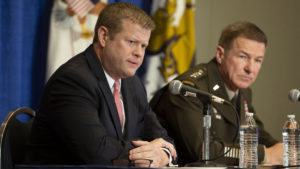The Army expects to release a list of characteristics it wants in the restarted Optionally Manned Fighting Vehicle (OMFV) as a top official outlined the new development strategy for replacement to the Bradley fighting vehicle.
“We are changing our process and you’re going to see very shortly a list of characteristics coming out – so we’re actually moving away from the word requirements because it means so much to those in the business that it actually constrains innovation, so we are coming out with a list of characteristics that we want for this Optionally Manned Fighting Vehicle,” Chief of Staff of the Army Gen. James McConville said Wednesday at an event hosted by the Center for a New American Security.

Last month, the Army said it canceled the previous solicitation effort for the potential $45 billion OMFV and would revise requirements before restarting the competition. Army officials called it a “tactical pause” (Defense Daily, Jan. 16).
The previous OMFV effort faced scrutiny when the Army accepted a single bid sample for the program’s prototype phase, an offering from General Dynamics [GD].
Then, earlier this month, the Army restarted the OMFV prototype solicitation effort when it released a market survey to industry, underscoring a focus on increasing vendor participation in the vehicle development phase (Defense Daily, Feb. 7).
McConville explained the Army will be asking industry to come up with designs, which the service will fund via Other Transaction Authorities (OTAs) agreements.
“We’re also going to ask industry to come in with technology that they think would fit in this design and we’re going to incentivize that. And then once we get that back, we’re going to take a look at the characteristics and say, ‘Hey we need to define these a little better,’” McConville said.
“So the characteristics will get a little sharper and it will go to a detail design and we’ll downselect from that and we’ll go to a prototype design and then we’ll actually make sure that we can build it,” he continued.
The Army will not release a set of requirements until the prototypes are built.
“What we believe is then we’ll know exactly what the traits are and we’ll be able to proceed in a much quicker manner without spending a lot of money or without requiring industry to go after requirements we didn’t think we needed or that were unattainable,” McConville said.
Speaking to reporters after the event, Secretary of the Army Ryan McCarthy acknowledged OMFV will be one of the programs the service will have some difficulty selling to Congress this year.
“We’re in many cases fighting history on that program as well,” he said.
Since OMFV is one of the programs in research and development, “it takes a lot of energy to communicate your performance…so we’re going to have to do a lot of what we’re doing right now: heavy communication to continue to inform them, to get them as confident as they can be with these decisions.”
Last week, the Army released its FY 2021 budget request, which included $1.5 billion for the overall Next-Generation Combat Vehicle modernization effort and specifically $328 million for OMFV (Defense Daily, Feb. 10).